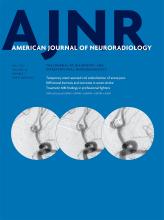Table of Contents
Perspectives
Practice Perspectives
- Baseline Survey of the Neuroradiology Work Environment in the United States with Reported Trends in Clinical Work, Nonclinical Work, Perceptions of Trainees, and Burnout Metrics
A voluntary survey was sent to practicing and out-of-training members of the ASNR. Four hundred thirty-two respondents across a broad range of experience reported: 93% with workdays extending at least 1 hour past expected; 71.9% reading more cases per hour compared with previous years; 79.5% sometimes-to-always interpreting cases faster than comfortable for optimal interpretation; and 67.8% sometimes or more often with inadequate time to discuss abnormal results. Burnout symptoms ranged between 49% and 75%. The trends and the correlations should be concerning to the leaders of radiology and warrant further monitoring.
Health Care Reform Vignette
General Contents
- Prevalence of Traumatic Findings on Routine MRI in a Large Cohort of Professional Fighters
Conventional 3T MR imaging was used to assess 499 fighters (boxers, mixed martial artists, and martial artists) and 62 controls for nonspecific WM changes, cerebral microhemorrhage, cavum septum pellucidum, and cavum vergae. Fighters had an increased prevalence of cerebral microhemorrhage (4.2% versus 0% for controls), cavum septum pellucidum (53.1% versus 17.7% for controls), and cavum vergae (14.4% versus 0% for controls). This study assessed MR imaging findings in a large cohort demonstrating a significantly increased prevalence of cavum septum pellucidum among fighters. Although cerebral microhemorrhages were higher in fighters than in controls, this finding was not statistically significant.
- The Use of Noncontrast Quantitative MRI to Detect Gadolinium-Enhancing Multiple Sclerosis Brain Lesions: A Systematic Review and Meta-Analysis
The authors evaluated 37 journal articles that included 985 patients with MS who had MR imaging in which T1-weighted postcontrast sequences were compared with noncontrast sequences obtained during the same MR imaging examination by using ROI analysis of individual MS lesions. DTI-based fractional anisotropy values were significantly different between enhancing and nonenhancing lesions, with enhancing lesions showing decreased FA. None of the other most frequently studied MR imaging biomarkers (mean diffusivity, magnetization transfer ratio, or ADC) were significantly different between enhancing and nonenhancing lesions. They conclude that noncontrast MR imaging techniques, such as DTI-based FA, can assess MS lesion acuity without gadolinium.
- Diffusional Kurtosis Imaging and Motor Outcome in Acute Ischemic Stroke
The authors evaluated 17 patients with stroke who underwent brain diffusional kurtosis imaging within 4 days after the onset of symptoms. Neurologic evaluation included the Fugl-Meyer Upper Extremity Motor scale in the acute phase and 3 months poststroke. The largest percentage signal changes of the lesioned hemisphere corticospinal tract were observed with axial kurtosis, with an average 12% increase compared with the contralateral corticospinal tract. The strongest associations between the 3-month Fugl-Meyer Upper Extremity Motor scale score and diffusion metrics were found for the lesioned/contralateral hemisphere corticospinal tract mean kurtosis and axial kurtosis ratios. They conclude that diffusion metrics related to kurtosis were found to be more sensitive than conventional diffusivity metrics to early poststroke corticospinal tract microstructural changes.
- Temporary Stent-Assisted Coil Embolization as a Treatment Option for Wide-Neck Aneurysms
The authors intended to treat 33 aneurysms between January 2010 and December 2015 with temporary stent-assisted coiling, which formed the series for this study. Incidental and acutely ruptured aneurysms were included. Sufficient occlusion was achieved in 97.1% of the cases. In 94%, the stent could be fully recovered. Complications occurred in 5 patients (14.7%). They conclude that temporary stent-assisted coiling is an effective technique for the treatment of wide-neck aneurysms. Safety is comparable with that of stent-assisted coiling and coiling with balloon remodeling.
- TIPIC Syndrome: Beyond the Myth of Carotidynia, a New Distinct Unclassified Entity
This study included 47 patients from 10 centers presenting between January 2009 through April 2016with acute neck pain or tenderness and at least 1 cervical image showing unclassified carotid abnormalities. The authors conducted a systematic, retrospective study of their medical charts and diagnostic and follow-up imaging. All patients presented with acute neck pain, and 8 presented with transient neurologic symptoms. Imaging showed an eccentric pericarotidian infiltration in all patients. An intimal soft plaque was noted in 16 patients, and a mild luminal narrowing was noted in 16 patients. The authors conclude that this study improves the description of an unclassified, clinico-radiologic entity, which could be described by the proposed acronym: Transient Perivascular Inflammation of the Carotid artery (TIPIC) syndrome.








